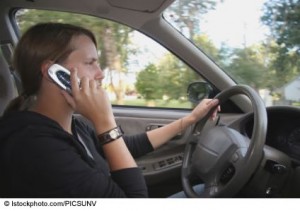 The notion that talking on a cell phone while driving a car isn’t safe seems obvious, yet what happens in the brain while it juggles the two tasks is not.
The notion that talking on a cell phone while driving a car isn’t safe seems obvious, yet what happens in the brain while it juggles the two tasks is not.
A study by a University of South Carolina psychology researcher featured in the journal, Experimental Psychology, provides a better understanding of why language – talking and listening, including on a cell phone – interferes with visual tasks, such as driving.
In two different experiments, associate professor of psychology Dr. Amit Almor found that planning to speak and speaking put far more demands on the brain’s resources than listening.
“We measured their attention level and found that subjects were four times more distracted while preparing to speak or speaking than when they were listening,” said Almor of the 47 people who participated in the experiment. “People can tune in or out as needed when listening.”
One experiment required participants to detect visual shapes on a monitor, and a second experiment required participants to use a computer mouse to track a fast-moving target on the screen. In both experiments, participants performed the visual task while listening to prerecorded narratives and responding to the narratives.
Almor calls the finding “very strong” and expects it to be even stronger in actual, interactive conversation. He and Tim Boiteau, a graduate student in linguistics, have repeated the experiment using 20 pairs of friends who engaged in real conversation while completing visual tasks. Those results are being compiled this summer.
“I anticipate the effect to be even stronger and more dynamic because, in conversation, people have the urge to contribute,” said Almor. “In conversation, we compete with the other person. I suspect that the greater the urge to speak, the greater the distraction from the visual task.”
In both experiments, Almor placed the participants in a circular, surround-sound environment in which the speakers were hidden and the voice shifted from the front, rear or either side.
Almor found that participants could complete the visual task in front of them more easily when the projected voice also was in front. This effect, while not so strong as the difference between preparing to speak or speaking and listening, suggests that simultaneously performing a language task and a visual task is easier when the tasks are in the same space physically and cognitively.
“Either people are used to face-to-face communication or, when they engage in a language task, they create a mental representation in their mind and place the voice somewhere in space,” Almor said. “In this case, that space is in front of them, which suggests that it may be easier to have all things that require attention occupy the same space.”
The finding may be useful in the development of new technologies, said Almor. In the case of a car, an internal speaker phone could project a speaker’s voice from the front so that it occupies the same place as the visual task of driving. The same could be applied in remote classroom instruction, in PowerPoint presentations and in military and pilot training.
Almor’s findings are particularly relevant in light of recent statistics.
The National Highway Traffic and Safety Administration (NHTSA) reported in April that 25 percent of all car accidents are caused by distractions. A survey done by Nationwide Mutual Insurance in 2007 indicated that 73 percent of drivers talk on cell phones while driving. Given that cell-phone sales have vaulted to 254 million in February 2008 up from (4.3 million in 1990), according to the Cellular Telecommunications & Internet Association, there is good reason for researchers to study the brain and how talking and listening on a cell phone interferes with driving a car.
At the University of South Carolina, Almor conducts research on language and memory (the brain’s ability to acquire, organize, revise and store information).
To access the current issue of Experimental Psychology, visit the Web site — www.psycontent.com/content/1618-3169 — and click on Number 4, Volume 55.
Source: University of South Carolina
